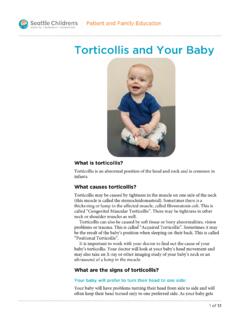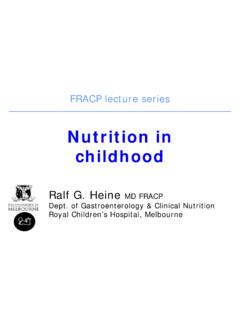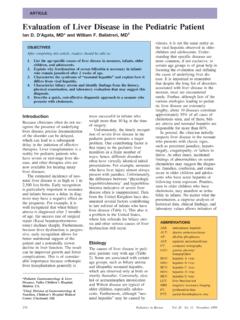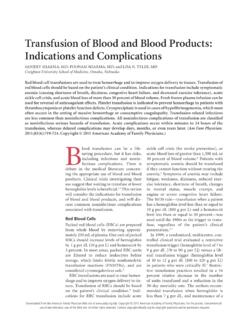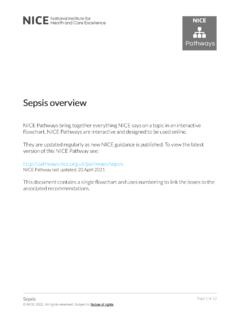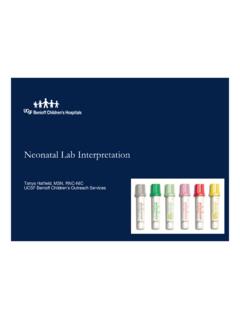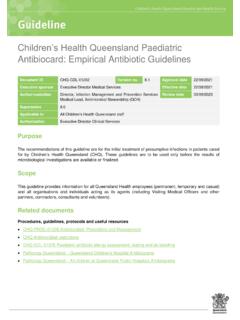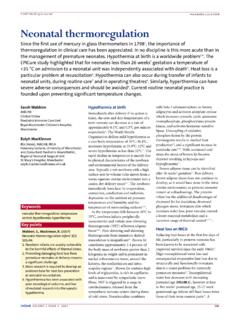Transcription of Neonatal Fever v6.0: ED Phase (0-28 days old)
1 Phase I ( )Last Updated: January 2019 Next Expected Revision: January 2024 2019 Seattle Children s Hospital, all rights reserved, Medical DisclaimerFor questions concerning this pathway,contact: !If CSFpleocytosis consider CSF Rapid Viral Qual. PCR No UA, urine culture CBC with diff, Blood culture CSF studies HSV work up if indicated (see box) CXR and respiratory viral panel (if respiratory symptoms) Stool PCR (if diarrhea)Begin clinical assessmentFocal Infection( , omphalitis, pneumonia)Begin empiric treatment Ampicillin and cefotaxime (or ceftazidime if cefotaxime unavailable) Acyclovir if HSV work up performed Admit all patientsOff PathwayYesHSV work up indicationsPerform and begin acyclovir for any of the following.
2 Historical and clinical features severe illness hypothermia lethargy seizures hepatosplenomegaly postnatal HSV contact vesicular rash conjunctivitis interstitial pneumonitisLaboratory features thrombocytopenia CSF pleocytosis >20 WBC/mm3 without clear bacterial infection ( , + Gram stain)!Other differentialdiagnosis for severelyill neonatesCSF Normative values0-1 month: CSF WBC <20/mm3>I month: CSF WBC <10/mm3!In well-appearinginfants withmultiple maternalHSV risk factors, consider HSV work upNeonatal Fever : ED Phase (0-28 days old)Explanation of Evidence RatingsSummary of Version ChangesApproval & Citationcomplete work upInability to obtain CSF in EDConsiderations forPretreated CSF Administer antibiotics (GOAL.)
3 Within 60 minutes) Refer to IR for lumbar puncture as inpatient Rapid CSF Bacterial PCR can be sent on pre-treated CSF that demonstrates pleocytosisConsiderations forPretreated CSFhypothermiaInclusion Criteria Fever 38 C (or a reliable history of Fever ) or hypothermia <36 C in children <28 days of age Exclusion Criteria Patients currently admitted to ICU or admitted >3 days Known immunodeficiency or cancer Patients with central venous catheters or VP shuntsGo to Inpatient Phase (0-28d)Urgent Care Transfer Guidelines (for 0-28 days)Well appearing neonates with Fever transfer via POV to an ED Ill appearing neonates with Fever : Initiate transport immediately Attempt to obtain labs Give antibiotics (IV or IM)hypothermiaDischarge Criteria(meets all) Eating well and well appearing No social/family concerns Reliable follow-up in 12-24 hours Outpatient plan accepted by PMD and familyNeonatal Fever .
4 ED Phase (29-56 days old)Explanation of Evidence RatingsSummary of Version ChangesNoNoLow Risk Criteria Well-appearing Previously healthy Full term ( 37 weeks) No focal bacterial infection Negative urinalysis WBC >5,000 and <15,000 mm3 Absolute bands <1,500 mm3 No discrete infiltrates on CXR if done Obtain CSF studies Begin ceftriaxone Considerations for severely ill patients and other clinical scenarios AdmitYesMeets all low risk criteria?Admit for observationCSF studies and antibiotics if worsens!Ceftriaxone contraindicated withhyperbilirubinemiaFocal Infection( , omphalitis, pneumonia)Off PathwayBronchiolitis?
5 (increased work of breathing, cough, tachypnea, wheezing)NoYesYes CBC with diff Blood culture UA, urine culture CXR and respiratory viral panel (if respiratory symptoms) Stool PCR (if diarrhea)CONSIDERNEONATAL Fever 29-56 days W/BRONCH ED PHASEA pproval & Citation 2019 Seattle Children s Hospital, all rights reserved, Medical DisclaimerFor questions concerning this pathway,contact: NoLast Updated: January 2019 Next Expected Revision: January 2024 Phase I ( )Inability to obtain CSF in EDConsiderations forPretreated CSF Administer antibiotics (GOAL: within 60 minutes) Refer to IR for lumbar puncture as inpatient Rapid CSF Bacterial PCR can be sent on pre-treated CSF that demonstrates pleocytosisConsiderations forPretreated CSFGo to Inpatient Phase (29-56d)!
6 If CSFpleocytosis consider CSF Rapid Viral Qual. PCR Inclusion Criteria Fever 38 C (or a reliable history of Fever ) or hypothermia <36 C in children 29-56 days of ageExclusion Criteria Patients currently admitted to ICU or admitted >3 days Known immunodeficiency or cancer Patients with central venous catheters or VP shuntshypothermiaUrgent Care Transfer Guidelines (for 29-56 days)Ill appearing neonates with Fever : Initiate transport immediately Attempt to obtain labs Give antibiotics (IV or IM)Does not meet low risk criteria.
7 Transfer to ED for additional work up and antibiotics Neonatal Fever : Inpatient Phase (0-28 days old)Daily re-evaluation Treat specific condition Narrow antibiotic agent if possible If HSV+, transfer to ID serviceDischarge Criteria (Meets all) Tolerating PO Well-appearing At 36 hours if cultures negative Adequate follow-up PMD and family agree with planDischarge Instructions PMD f/u within 48-72 hoursNeg. culturesPos. cultures!Considerdischarge at24 hours if non-HSVviral studies positive& patient well-appearingYesNoWhen to discontinue acyclovirCSF Pleocytosis>20 WBC/mm3?
8 Improving and meets discharge criteria?Further evaluation per primary teamAmpicillin +Cefotaxime(or Ceftazidime if Cefotaxime unavailable)Ampicillin +gentamicinNoYesExplanation of Evidence RatingsSummary of Version ChangesHSV discharge criteriaApproval & Citation 2019 Seattle Children s Hospital, all rights reserved, Medical DisclaimerFor questions concerning this pathway,contact: Last Updated: January 2019 Next Expected Revision: January 2024 Phase II (INPATIENT)!If CSFpleocytosis consider CSF Rapid Viral Qual. PCR Inclusion Criteria Fever 38 C (or a reliable history of Fever )
9 Or hypothermia <36 C in children <28 days of age Exclusion Criteria Patients currently admitted to ICU or admitted >3 days Known immunodeficiency or cancer Patients with central venous catheters or VP shuntshypothermiaInability to obtain CSF in EDConsiderations forPretreated CSF ED administers antibiotics Refer to IR for lumbar puncture as inpatient Rapid CSF Bacterial PCR can be sent on pre-treated CSF that demonstrates pleocytosisConsiderations forPretreated CSFR eview Urinalysis results Cefotaxime Monotherapy(or Ceftazidime if Cefotaxime unavailable)NegativePositiveNeonatal Fever : ED Phase (29-56 days old) with BronchiolitisExplanation of Evidence RatingsSummary of Version ChangesSymptoms of Bronchiolitis.
10 (increased work of breathing, cough, tachypnea, wheezing)Consider UA/Culture in patients who are persistently febrile or vomitingUA +Off PathwayUA OR UA NOT INDICATEDB lood CXCeftriaxoneAdmit to inpatient on UTI and Bronchiolitis pathwayinpatient on UTIand BronchiolitisCONSIDER BRONCHIOLITIS PATHWAYS igns of poor perfusion or mental status changes or sepsis score > 3 Continue workup per Neonatal Fever (29-56d) pathwayYESNO!Onset of NEW Fever during hospitalization in patients with bronchiolitis can be indicative of a serious bacterial infection.





